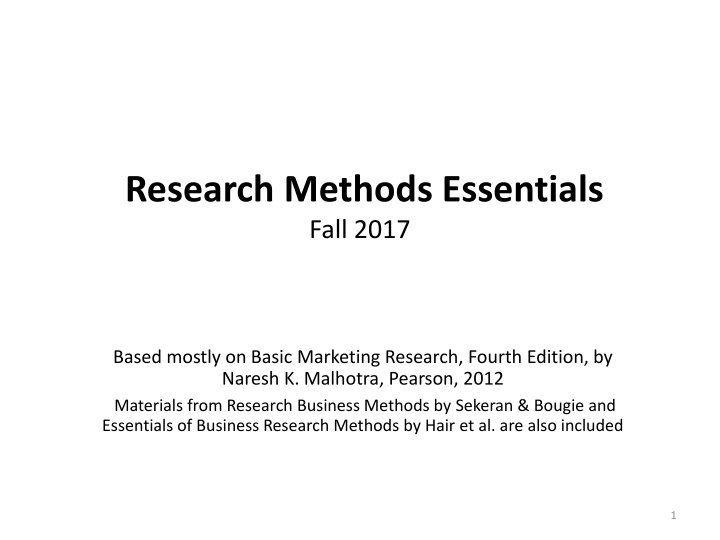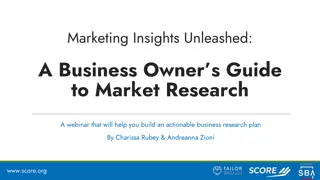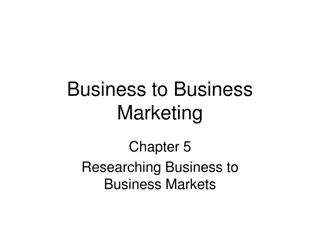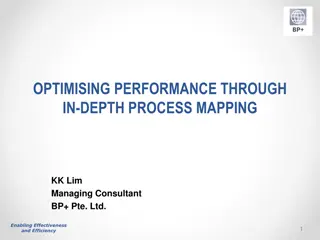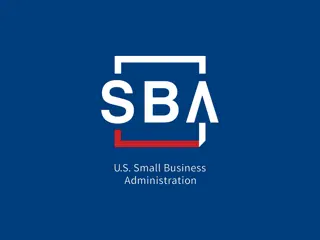Introduction to Business Research Essentials
Business research involves organized, systematic data collection and analysis to improve decision-making. It includes defining problems, developing approaches, formulating research designs, collecting and analyzing data, and presenting reports. The process aims to address issues such as market share loss, employee commitment, and safety concerns like texting while driving. A strong theoretical foundation guides researchers in gathering and interpreting data effectively.
Download Presentation

Please find below an Image/Link to download the presentation.
The content on the website is provided AS IS for your information and personal use only. It may not be sold, licensed, or shared on other websites without obtaining consent from the author.If you encounter any issues during the download, it is possible that the publisher has removed the file from their server.
You are allowed to download the files provided on this website for personal or commercial use, subject to the condition that they are used lawfully. All files are the property of their respective owners.
The content on the website is provided AS IS for your information and personal use only. It may not be sold, licensed, or shared on other websites without obtaining consent from the author.
E N D
Presentation Transcript
Research Methods Essentials Fall 2017 Based mostly on Basic Marketing Research, Fourth Edition, by Naresh K. Malhotra, Pearson, 2012 Materials from Research Business Methods by Sekeran & Bougie and Essentials of Business Research Methods by Hair et al. are also included 1
Brief Contents Definition of Business Research - Theory pg. 3 The Research Process Steps pg. 4 Step 1 and Step 2: Defining a Problem and Developing an Approach to the Problem pg. 5-8 Step 3: Formulating a Research Design pg. 9-37 Step 4: The Field Work/Data Collection Process pg. 38 Step 5: Preparing and Analyzing Data pg. 39-48 Step 6: Preparing and Presenting the Report pg. 49-50 2
Definition of Business Research Business research is the organized, systematic, data-based, critical, and objective identification, collection, analysis, dissemination, and use of information, for the purpose of improving decision making related to the identification and solution of problems and opportunities. In essence, business research provides the necessary information to guide managers to make informed decisions to successfully deal with problems and/or opportunities. Examples of problems: loss of market share; young workers in organization show low levels of commitment to the organization; texting while driving leads to accidents. The foundation of research should be objective and based on theoretic foundation. A theory is based on principles that have empirical support and accepted as knowledge. Thus, a theory provides a researcher with general principles on which to base research work. Moreover, a theory serves as a framework that can be used by the researcher to gather and interpret the data collected. 3
The Research Processinvolves several steps that define the tasks to be accomplished in conducting a business research study. Step 1: Defining the Problem this is the most important step, because all other steps will be based on this definition. Step 2: Developing an Approach to the Problem development of a broad specification of how the problem will be addressed allows the researcher to break the problem into salient issues and manageable pieces. Step 3: Formulating a Research Design this is a framework for conducting the research project that specifies the procedures necessary for obtaining required information. It details the statistical methodology needed to solve the problem and thus the data requirements needed from data collection. Step 4: Doing Field Work or Collecting Data a field force (through personal interviewing, phone, mail, or electronic surveys) gathers project data. Step 5: Preparing and Analyzing Data the editing, coding, transcription or uploading and verification of data allow researchers to derive meaning from data. Step 6: Preparing and Presenting the Report the findings are communicated to the manager and/or client. 4
Step 1 and Step 2: The Problem Definition and Approach Development A broad statement of the general problem and identification of the specific components of the business research problem. Tasks Involved Discussions with Decision Makers Interviews with Experts Secondary Data Analysis Qualitative Research Environmental Context of the Problem Step 1: Problem Definition Management Decision Problem Research Problem Step 2: Approach to the Problem Analytical Framework and Models Research Specification of Information Needed Questions and Hypotheses Step 3: Research Design 5
Components of a Well-defined Business Research Problem A well-defined research problem consists of both broad statement and a list of specific components. A broad definition does not provide guidelines for subsequent steps in research. A narrow definition, on the other hand, may preclude the consideration of some courses of action. In either case, the solution that is reached will not be directly related to the problem and may be of little use to the manager. Common Errors Problem Definition is too Narrow May miss some important components of the problem e.g. Changing prices in response to a competitor s price change. Problem Definition is too Broad Does not provide guidelines for subsequent steps e.g., Improving the company s image 6
Research Questions and Hypotheses Research Questions (RQs) Refined statements of the specific components of the problem Hypothesis (H) An unproven statement or proposition about a factor or phenomenon that is of interest to the researcher. Hypothesis are mostly based on secondary data (literature review). By focusing on each component of the problem and the analytical framework and models, research questions, and hypotheses, the researcher can determine what information should be obtained. 7
Example of Hypothesis Development Based on Secondary Data RQ1: What are consumers perceptions of bottled water in comparison to tap water? Bottled water companies have a strong influence on consumers perceptions because of their advertising tactics (Gleick, 2010, pg 6). Fear tactics and other advertising methods are used to depict bottled water as the healthiest option and or play up the supposed health risks of tap water (Gleick, 2010, pg 6). Consequently, bottled water is seen as a more pure choice, a safer alternative to tap water with better quality and better taste (Yao, 2011). Poor past experiences with tap water such as foul odor or contamination can also result in consumers believing that bottled water is safer, healthier and has better taste (Viscsi, Huber & Bell, 2014). Based on this studies, we expect the following: H1: Consumers perceive bottled water to be higher quality than tap water: they think is safer, healthier and has better taste. 8
Step 3: Formulating a Research Design A research design is a framework for conducting the business research project. It details the procedures necessary for obtaining the information needed to structure or solve business research problems. It is important to have a good research design so that the business research project is conducted effectively and efficiently. Tasks Involved In a Research Design Define the Information Needed Design the Exploratory, Descriptive, and/or Causal Phases of the Research Specify the Measurement and Scaling Procedures Construct and Pretest a Questionnaire Specify the Sampling Process and the Sample Size Develop a Plan of Data Analysis 9
A Classification of Research Designs Used in Business Research Design Exploratory Research Design Conclusive Research Design A type of research design that has as its primary objective the provision of insights into and comprehension of the problem situation confronting the researcher. Research designed to assist the decision maker in determining, evaluating, and selecting the best course of action for a given situation. Causal Research Descriptive Research A type of conclusive research whose major objective is to obtain evidence regarding cause-and-effect (causal) relationships. A type of conclusive research that has as its major objective the description of something usually market characteristics or functions. Cross-Sectional Design Longitudinal Design A type of research design involving the one-time collection of information from any given sample of population elements. A type of research design involving a fixed sample of population elements that is measured repeatedly. 10
A Comparison of Basic Research Designs Exploratory Descriptive Causal Discovery of ideas and insights Flexible. Describe market characteristics or functions Marked by the prior formulation of specific hypotheses Determine cause and effect relationships Manipulation of one or more independent variables Objective: Versatile Character- istics: Often the front end of total research design Expert surveys Preplanned and structured design. Control of other mediating variables Secondary data (quantitative) Surveys Panels Experiments Pilot surveys Case studies Method: Secondary data (qualitative) Qualitative Research Observational and other data 11
Descriptive Research The following questions form the basis for describing the research to be conducted: The six Ws Who should be considered? Where should the respondents be contacted to obtain the required information? When should the information be obtained from the respondents? What information should be obtained from the respondents? Why are we obtaining information from the respondents? What is the Way in which we are going to obtain information from the respondents? 12
Exploratory Research Design: Secondary Data Primary Data data originated by the researcher for the specific purpose of addressing the research problem. The collection of primary data involves all six steps of the research process. Secondary Data data collected for some purpose other than the problem at hand. - often found internally but also externally (published materials, databases, or from syndicated services) - characterized as being easily available and relatively inexpensive - can cover a broad range of factors that affect the problem at hand - do not always fit the current specific problem, but can be useful in developing an approach and providing a comprehensive understanding of the problem. !!! Examine available secondary data as a prerequisite to collecting primary data. 13
Exploratory Research Design: Qualitative Data vs. Quantitative Data Definition Qualitative Research Quantitative Research An unstructured, exploratory research methodology based on small samples, which provides insights and understanding of the problem setting A research methodology that seeks to quantify the data and typically, applies some form of statistical analysis Objective To gain a qualitative understanding of the underlying reasons and motivations Sample Small number of nonrepresentative cases Data collection Unstructured Data analysis Nonstatistical Outcome Develop an initial understanding. understanding To quantify the data and generalize the results from the sample to the population of interest. Large number of representative cases. Structured Statistical Recommend a final course of action. 14
A Classification of Qualitative Research Procedures Qualitative Research Procedures Direct Indirect (disguised) (Nondisguised) -the purposes of the project are disclosed to the respondent or are obvious given the nature of the interview -the purposes of the project are disguised from the respondents Depth Interviews Projective Techniques Focus Groups Association Techniques Completion Techniques Construction Techniques Expressive Techniques 15
Focus Group Interviews Conducted by a trained moderator among a small group of respondents in an unstructured and natural manner. Characteristics of Focus Groups 8 - 12 Group Size Group Composition Homogeneous; respondents prescreened Physical Setting Relaxed, informal atmosphere Time Duration 1 3 hours Recording Use of audiocassettes and videotapes Moderator Observations, interpersonal, and communication skills of the moderator are critical 16
Steps Involved in Conducting a Focus Group Examine the objectives of the research project. Provides the rationale for conducting the focus group. Specify the objectives. Outlines the goals of the study in order to guide the interview. State the questions to be answered from the focus group. Lists a detailed set of questions to be answered. Write a screening questionnaire. Ensures that participants represent an appropriate sample for the study. Design the focus group environment. Recruit focus group participants. Develop a moderator s outline. Ensures that the moderator understands the nature of the study and the key findings desired by the client. Conduct the interview. Review tapes and analyse data. Allows the researcher to uncover inconsistent responses, missed remarks, nonverbal communication and new ideas. Summarize findings and plan follow-up research. Further research undertaken to probe further into the issues and sample statistically significant populations. 17
Depth Interviews Direct, personal interviews in which a single respondent is probed by a highly skilled interviewer to uncover underlying motivations, beliefs, attitudes, and feelings on a topic. These interviews typically last from 30 minutes to more than an hour. Probing is done by asking questions as: Why do you say that?'' That's interesting, can you tell me more?'' Would you like to add anything else? 18
Other Methods of Gathering and Analyzing Qualitative Data Content analysis an observational research method that is used to systematically evaluate contents of all forms. Can be used to analyze newspapers, websites, advertisements, recordings of interviews, and the like. It enables the researcher to systematically identify properties of large amounts of textual information. Narrative analysis - an approach that aims to elicit and scrutinize the stories we tell about ourselves and their implications for our lives. It is often collected via interviews. It is focused on a process of temporal order. Has been used to study impulsive buying, customers responses to advertisements, relationships between providers and customers. Analytic induction starts with a rough definition of a problem (why do people use drugs), continues with a hypothetical explanation of the problem (to relieve their pain), and then proceeds with the examination of cases (collection of data via interviews). 19
Quantitative Data: The Survey Method Survey Method: A structured questionnaire given to a sample of a population, designed to elicit specific information from respondents; the survey method of obtaining information is based on questioning respondents. Perhaps the biggest issue researchers face is how to motivate respondents to candidly answer their questions. Questions regarding behavior, intentions, attitudes, awareness, motivations, and demographic and lifestyle characteristics all lend themselves to survey research. Methods of improving response rate include, prior notification, incentives (monetary or nonmonetary, prepaid or promised), follow up and other facilitators (such as personalization). 20
Survey Research Advantages Disadvantages Ease: Questionnaires are relatively easy to administer. Respondents may be unable or unwilling to provide the desired information. Reliability: Using fixed-response (multiple-choice) questions reduces variability in the results that may be caused by differences in interviewers and enhances reliability of the responses. Structured data collection involving a questionnaire with fixed-response choices may result in loss of validity for certain types of data, such as beliefs and feelings. Properly wording questions is not easy. Simplicity: It also simplifies coding, analysis, and interpretation of data. 21
Relative Advantages of Different Survey Methods METHOD ADVANTAGES Telephone Fast High Sample Control Good control of field force Good response rate Moderate Cost In-Home Complex questions can be asked Good for physical stimuli Very good sample control High quantity of data Very good response rate DISDAVANTAGES No use of physical stimuli Limited to simple questions Low quantity of data Low control of field force High social desirability Potential for interviewer bias Most expensive Mall Intercept Complex questions can be asked Very good for physical stimuli High social desirability Potential for interviewer bias Very good control of environment Very good response rate Moderate quantity of data High cost 22
Relative Advantages of Different Survey Methods (Cont.) METHOD CAPI ADVANTAGES Complex questions can be asked DISDAVANTAGES High social desirability Very good for physical stimuli Moderate quantity of data Very good control of environment High cost Very good response rate Low potential for interviewer bias No field force problems Limited to simple questions Mail No interviewer bias Low sample control for cold mail Moderate/high quantity of data No control of environment Low social desirability Low response rate for cold mail Low/moderate cost Low speed No field force problems Limited to simple questions Electronic No interviewer bias Low sample control Low cost No control of environment Low social desirability Low response rate High speed Moderate quantity of data 23
Observation Methods Observation The recording of behavioural patterns of people, objects, and events in a systematic manner to obtain information about the phenomenon of interest Personal Observation An observational research strategy in which human observers record the phenomenon being observed as it occurs. The observer does not attempt to manipulate the phenomenon being observed but merely records what takes place. For example, a researcher might record traffic counts and observe traffic flows in a department store. Mechanical Observation An observational research strategy in which mechanical devices, rather than human observers, record the phenomenon being observed. Examples: the AC Nielsen audimeter, turnstiles that record the number of people entering or leaving a building, on-site cameras (still, motion picture, or video), optical scanners in supermarkets; eye-tracking monitors, pupilometers, psychogalvanometers, voice pitch analyzers, devices measuring response latency. 24
Ethical Issues The anonymity or confidentiality of respondents should be protected. All statements and promises used to solicit participation should be honoured. Research should be conducted in a way that does not embarrass or harm the respondents. Studies conducted at Universities require Ethical Approval from an Ethics Committee. 25
Primary Scales of Measurement __________________________________________________________________________________________ Primary Basics Common Scale Characteristics Examples ___________________________________________________________________________________________ Nominal Numbers Social Security identify numbers, numbering and classify of football play- objects ers Ordinal Numbers indicate Quality rankings, the relative po- rankings of sitions of the teams in a objects but not tournament the magnitude of differences between them Interval Differences be- Temperature tween objects can (Fahrenheit, be compared; Celsius) zero point is arbitrary Ratio Zero point is Length, fixed; ratios of weight scale values can be computed Marketing Examples Permissible Statistics Brand numbers, store types, sex classi- fication Percentages, mode Preference rankings, market position, social class Percentile, median Attitudes, opin- ions, index numbers Range, mean, standard deviation Age, income, costs, sales, Geometric mean, (All) 26
A Classification of Scaling Techniques Scaling Techniques Comparative Scales Noncomparative Scales A scaling technique in which each stimulus object is scaled independently of the others. A scaling technique in which there is direct comparison of stimulus objects with one another. Itemized Rating Scales Continuous Rating Scales Paired Comparison Constant Sum Rank Order Likert Stapel Semantic Differential 27
A Classification of Noncomparative Rating Scales Noncomparative Rating Scales A scaling technique in which each stimulus object is scaled independently of the other objects in the stimulus set Itemized Rating Scales Continuous Rating Scales A measurement scale having numbers and/or brief descriptions associated with each category A measurement scale in which respondents rate the objects by placing a mark at the appropriate position on a line that runs from one extreme of the criterion variable to the other Semantic Differential Stapel Likert 28
Itemized Rating Scales The respondents are provided with a scale that has a number or brief description associated with each category. The categories are ordered in terms of scale position; and the respondents are required to select the specified category that best describes the object being rated. The commonly used itemized rating scales are the Likert, semantic differential and Stapel scales. Likert Scale - A measurement scale with five response categories ranging from strongly disagree to strongly agree , which requires the respondents to indicate a degree of agreement or disagreement with each of a series of statements related to the stimulus object (most widely used in business). Semantic Differential - A seven-point rating scale with end points associated with bipolar labels that have semantic meaning. Stapel Scale - A scale for measuring attitudes that consists of a single adjective in the middle of an even-numbered range of values. 29
Itemized Rating Scale Decisions 1. Number of categories While there is no single, optimal number, traditional guidelines suggest that there should be between five and nine categories. 2. Balanced vs. unbalanced In general, the scale should be balanced to obtain objective data. 3. Odd or even number of If a neutral or indifferent scale response is possible for categories at least some of the respondents, an odd number of categories should be used. 4. Forced versus nonforced In situations where the respondents are expected to have no opinion, the accuracy of data may be improved by a nonforced scale. 5. Verbal description An argument can be made for labeling all or many scale categories. The category descriptions should be located as close to the response categories as possible. 30 6. Physical form A number of options should be tried and the best one selected.
Questionnaire Definition: A questionnaire is a formalized set of questions for obtaining information from respondents. Objectives: Translate the information needed into a set of specific questions that respondent can and will answer. Uplift, motivate, and encourage the respondent to become involved in the interview, to cooperate, and to complete the interview. Minimize response error. Pretesting - the testing of the questionnaire on a small sample of respondents for the purpose of improving the questionnaire by identifying and eliminating potential problems before using it in the actual survey. Pretesting should be done always. 31
Questionnaire Design Process Specify the Information Needed Specify the Type of Interviewing Method Determine the Content of Individual Questions Design the Question to Overcome the Respondent s Inability and Unwillingness to Answer Decide on the Question Structure Determine the Question Wording Arrange the Questions in Proper Order Identify the Form and Layout Reproduce the Questionnaire Eliminate Bugs by Pretesting 32
When working on a questionnaire: Define the issue who, what, when, where, why and way Use ordinary words that match the vocabulary level of respondents Use unambiguous words avoid often, frequently, sometimes, usually, normally, regularly, etc. because they have limited usage in business Do not lead or bias the respondent to what the answer should be Use dual statements statements should be positive and negative 33
Determine the Order of Questions 1. The opening questions should be interesting, simple, and nonthreatening. 2. Qualifying questions should serve as the opening questions. 3. Basic information (information that relates directly to the business research problem) should be obtained first, followed by classification (socioeconomic and demographic characteristics used to classify respondents), and, finally, identification information (includes name, address and phone number). 4. Difficult, sensitive, or complex questions should be placed late in the sequence. 5. General questions should precede the specific questions. 6. Questions should be asked in a logical order. 34
Observational Forms Department Store Project Who: purchasers, browsers, males, females, parents with children, or children alone What: products/brands considered, products/brands purchased, size, price of package inspected, or influence of children or other family members When: day, hour, date of observation Where: inside the store, checkout counter, or type of department within store Why: influence of price, brand name, package size, promotion, or family members on the purchase Way: personal observer disguised as sales clerk, undisguised personal observer, hidden camera, or obtrusive mechanical device 35
Sampling Design Process Who should and who should not be included in a sample Define the Population Determine the Sampling Frame Select Sampling Technique(s) Determine the Sample Size Execute the Sampling Process 36
Sample Sizes Used in Business Research Studies ___________________________________________________________ Type of Study Minimum Size Typical Range __________________________________________________________ Problem identification research (e.g., market potential) 500 1000-2500 Problem solving research (e.g., pricing ) 200 300-500 Product tests 200 300-500 Test marketing studies 200 300-500 TV/radio/print advertising (per commercial or ad tested) 150 200-300 Test-market audits 10 stores 10-20 stores Focus groups 6 groups 10-15 groups ___________________________________________________________ 37
Step 4: The Field Work/Data Collection Process Selection of Field Workers Training of Field Workers Supervision of Field Workers Validation of Field Workers Evaluation of Field Workers 38
Step 5: Preparing and Analyzing Data Questionnaire Checking - A questionnaire returned from the field may be unacceptable for several reasons. Parts of the questionnaire may be incomplete. The pattern of responses may indicate that the respondent did not understand or follow the instructions. The responses show little variance. One or more pages are missing. The questionnaire is received after the pre-established cut-off date. The questionnaire is answered by someone who does not qualify for participation. 39
Selecting a Data Analysis Strategy MULTIVARIATE TECHNIQUES Statistical techniques suitable for analyzing data when there are two or more measurements on each element and the variables are analyzed simultaneously. Multivariate techniques are concerned with the simultaneous relationships among two or more phenomena. UNIVARIATE TECHNIQUES Statistical techniques appropriate for analyzing data when there is a single measurement of each element in the sample; or, if there are several measurements of each element, each variable is analyzed in isolation. 40
Basic Analysis - Frequency Distribution A mathematical distribution whose objective is to obtain a count of the number of responses associated with different values of one variable and to express these counts in percentage terms. In a frequency distribution, one variable is considered at a time. A frequency distribution for a variable produces a table of frequency counts, percentages, and cumulative percentages for all the values associated with that variable. It indicates the extent of out-of range, missing, or extreme values. A frequency distribution should be obtained for each variable in the data. 41
Statistics Associated with Frequency Distribution Measures of Central Tendency- statistics that describe a location within a data set. 1. Mean the average; that value obtained by summing all elements in a set and dividing by the number of elements. 2. Mode the value that occurs the most in a sample distribution. It represents the highest peak of the distribution. 3. Median the value above which half of the values fall and below which half of the values fall. Measures of Variability - statistics that indicate the distribution s dispersion. 1. Range the difference between the smallest and largest values of a distribution. 2. Variance the mean squared deviation of all the values from the mean. The variance can never be negative. 3. Standard Deviation the square root of the variance. 42
A Classification of Hypothesis Testing Procedures Hypothesis Testing Test of Association -cross-tabulation -correlation -regression Test of Difference -t-tests -ANOVA 43
Test of Association - Cross-tabulation A statistical technique that describes two or more variables simultaneously and results in tables that reflect the joint distribution of two or more variables that have a limited number of categories or distinct values. While a frequency distribution describes one variable at a time, a cross-tabulation describes two or more variables simultaneously. In cross-tabulation, the cell percentages can be computed either column-wise, based on column totals, or row-wise, based on row totals. The general rule is to compute the percentages in the direction of the independent variable, across the dependent variable. 44
Hypothesis Testing Related to Differences Parametric tests assume that the variables of interest are measured on at least an interval scale. These tests can be further classified based on whether one or two or more samples are involved. The samples are independent if they are drawn randomly from different populations. For the purpose of analysis, data pertaining to different groups of respondents, e.g., males and females, are generally treated as independent samples. The samples are paired when the data for the two samples relate to the same group of respondents. 45
The t Distribution and the t-test Hypotheses related to differences in the population can be tested using the t distribution. Different forms of t-test are suitable for testing hypotheses one-sample t-test - Statements about a single variable and a standard (i.e., the average monthly household expenditure on groceries exceeds $500 ) two independent samples t-test - two samples that are not experimentally related. The measurement of one sample has no effect on the values of the other sample (i.e., there are significant differences between men and women in terms of their attitudes toward Star Wars ) paired samples t-test - a test for differences in the means of paired samples. In hypothesis testing, the observations are paired so that the two sets of observations relate to the same respondents (i.e., Shoppers consider brand name to be more important than price when purchasing fashion clothing ). 46
Testing Hypotheses for More than Two Samples Analysis of Variance (ANOVA) A statistical technique for examining the differences among means for two or more populations. Differences in the mean values of more than two groups: Various segments differ in terms of their volumes of product consumption. Brand evaluations of groups exposed to different commercials vary. Retailers, wholesalers, and agents differ in their attitudes toward the firm distribution policies. Users, nonusers, and former users of a brand differ in their attitudes toward the brand. Specifically, users have more positive attitudes toward the brand in comparison to nonusers and former users. 47
Regression Analysis A statistical procedure for analyzing associative relationships between a metric dependent variable and one or more independent variables (does not imply or assume any causality). Usages: 1. Determine whether the independent variables explain a significant variation in the dependent variable: whether a relationship exists. Determine how much of the variation in the dependent variable can be explained by the independent variables: strength of the relationship. Determine the structure or form of the relationship: the mathematical equation relating the independent and dependent variables. Predict the values of the dependent variable. Control for other independent variables when evaluating the contributions of a specific variable or set the variables. 2. 3. 4. 5. 48
Step 6: Preparing and Presenting the Report Format Title page Letter of transmittal, Letter of authorization Table of contents List of tables, graphs, appendices, exhibits Executive summary (major findings, conclusions, recommendations) Problem definition (background and statement) Approach to the problem Research design, information needs, data collection from secondary sources, data collection from primary sources, scaling techniques, questionnaire development and pretesting, field work Data analysis (methodology, plan of data analysis) Results Limitations and caveats Conclusions and recommendations Exhibits (questionnaires and forms, statistical output, lists, bibliography). 49
Report Writing Readers - a report should be written for a specific reader or readers, for example, the marketing managers who will use the results. Easy to follow - the report should be easy to follow. It should be structured logically and written clearly. Presentable and professional appearance - The looks of a report are important. Objective - Objectivity is a virtue that should guide report writing. The rule is, "Tell it like it is." Reinforce text with tables and graphs - It is important to reinforce key information in the text with tables, graphs, pictures, maps, and other visual devices. Terse - A report should be terse and concise, yet, brevity should not be achieved at the expense of completeness. 50
